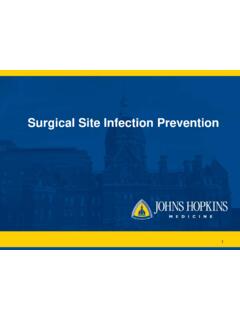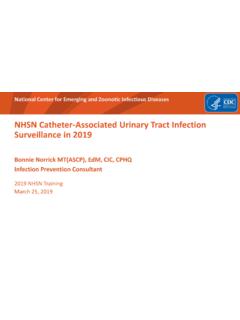Transcription of National Healthcare Safety Network (NHSN) Overview
1 January 2020 1-1 nhsn Overview National Healthcare Safety Network ( nhsn ) Overview The nhsn is a secure, Internet-based surveillance system that expands and integrates patient and Healthcare personnel Safety surveillance systems managed by the Division of Healthcare Quality Promotion (DHQP) at the Centers for Disease Control and Prevention. In addition, facilities that participate in certain reporting programs operated by the Centers for Medicare and Medicaid Services (CMS) can do so through use of nhsn . Furthermore, some states use nhsn as a means for Healthcare facilities to submit data on Healthcare -associated infections (HAIs) and transfusion-related adverse events mandated through their specific state legislation.
2 nhsn enables Healthcare facilities to collect and use data about HAIs, adherence to clinical practices known to prevent HAIs, the incidence or prevalence of multidrug-resistant organisms within their organizations, trends and coverage of Healthcare personnel Safety and vaccination, and adverse events related to the transfusion of blood and blood products. The nhsn includes six components: Patient Safety , Long-term Care Facility, Outpatient Dialysis, Healthcare Personnel Safety , Biovigilance, and Outpatient Procedure (Figure 1). Figure 1: nhsn Components nhsn ComponentsPatient SafetyLong-term Care Facility Outpatient DialysisHealthcare Personnel Safety BiovigilanceOutpatient Procedure January 2020 1-2 nhsn Overview The Patient Safety Component includes four modules that focus on events associated with medical devices, surgical procedures, antimicrobial agents used during Healthcare , and multidrug resistant organisms.
3 Device-associated Module: o Bloodstream Infection (CLABSI Central line-associated bloodstream infection) o Central line insertion practices (CLIP) adherence o Urinary Tract Infection (CAUTI Catheter-associated urinary tract infection) o Pediatric Ventilator-associated events (PedVAE) (NICU and pediatric locations only) o Ventilator-associated events (VAE) (adult locations only) o Pneumonia (VAP Ventilator-associated pneumonia) - in pediatric locations (in-plan* or off-plan*), or NICU and adult locations (off-plan* only) Procedure-associated Module: o Surgical Site Infection (SSI) Antimicrobial Use and Resistance Module (AUR) Multidrug-Resistant Organism and Clostridium difficile Infection (MDRO/CDI) Module *Note: In-plan surveillance means that the facility has committed to following the nhsn surveillance protocol, in its entirety, for that particular event, as shown in the facility s nhsn monthly reporting plan.
4 Off-plan surveillance is surveillance that is done because a facility has decided to track a particular event for internal use. Data that are entered into nhsn off-plan are not included in NSHN annual reports or other nhsn publications. A facility makes no commitment to follow the nhsn protocol for off-plan events. Further, off-plan data cannot be uploaded into nhsn via Clinical Document Architecture (CDA) and must be manually entered. Instructions and standardized surveillance methods and definitions for each module of the Patient Safety Component are provided in this manual and on the nhsn website ( ).
5 Modules may be used singly or simultaneously. The nhsn Long-term Care Facility Component provides long-term care facilities (LTCFs) with standardized surveillance methods and definitions for three modules: (1) Multidrug resistant organism (MDRO) and Clostridioides difficile Infection (CDI) laboratory-identified (LabID) Events; (2) Urinary Tract Infections (UTI); and (3) Prevention Process Measures. The component is ideal for use by nursing homes, skilled nursing facilities, chronic care facilities, and assisted living and residential care facilities. LTCF surveillance protocols, training materials, data collection forms, instructions, and other supporting materials are provided on the Long-term Care Facility Component website: Outpatient hemodialysis centers have several surveillance options tailored to their patients and setting in the Dialysis Component.
6 The component consists of 3 modules: 1) Dialysis Event; (2) Prevention Process Measures; and (3) Dialysis Patient Influenza Vaccination. Facilities that treat hemodialysis outpatients should refer to the Dialysis Component instructions and standardized surveillance methods and definitions at There are two modules in the Healthcare Personnel Safety (HPS) Component of nhsn : the Healthcare Personnel Exposure Module and the Healthcare Personnel Vaccination Module. These modules may be used separately or simultaneously. Instructions and standardized surveillance methods January 2020 1-3 nhsn Overview and definitions for each module are provided in the nhsn Manual: HPS Component Protocol The nhsn Biovigilance Component, Hemovigilance Module facilitates National surveillance of transfusion-related recipient adverse events.
7 The Hemovigilance Module is designed for transfusion service staff to collect data on annual facility and transfusion service characteristics, individual reports on adverse transfusion reactions, errors or accidents associated with adverse reactions, and monthly counts of transfused or discarded components. The Hemovigilance Module surveillance protocol, training materials, data collection forms, instructions, and other supporting materials are provided on the Hemovigilance Module website: The Outpatient Procedure Component (OPC) includes two modules that focus on adverse events associated with surgical procedures performed in Ambulatory Surgery Centers (ASCs).
8 The two modules include Same Day Outcome Measures and Surgical Site Infections. Same Day Outcome Measures (OPC-SDOM) are a grouping of outpatient care quality indicators that represent a broad range of risks encountered by patients accessing care in various outpatient settings. The four individual outcome measures are: o Patient Burn o Patient Fall o Wrong Site, Wrong Side, Wrong Patient, Wrong Procedure, Wrong Implant o All-Cause Hospital Transfer/Admission Surgical Site Infection (OPC-SSI) - SSI surveillance for outpatient operative procedures using the Outpatient Procedure Component (OPC) replaces the use of the Patient Safety Component SSI event chapter for ASCs.
9 The OPC surveillance protocols, training materials, data collection forms, instructions, and other supporting materials are provided on the Outpatient Procedure Component website: surveillance Techniques Some of the options in the following modules require active, patient-based, prospective surveillance of events and their corresponding denominator data by a trained Infection Preventionist (IP). This means that the IP shall seek out infections during a patient s stay by screening a variety of data sources, such as laboratory, pharmacy, admission/discharge/transfer, radiology/imaging, and pathology databases, as well as patient charts, including history and physical exam notes, nurses /physicians notes, temperature charts, etc.
10 Others may be trained to screen data sources for these infections, but the IP must make the final determination. Laboratory-based surveillance should not be used alone, unless all possible criteria for identifying an infection are solely determined by laboratory evidence (for example, LabID event detection in the MDRO/CDI Module). Retrospective chart reviews should be used only when patients are discharged before all information can be gathered. nhsn forms should be used to collect all required data, using the nhsn definitions of each data field. To minimize the IP s data collection January 2020 1-4 nhsn Overview burden, others may be trained to collect the denominator data and process of care data (for example, central line insertion practices).












